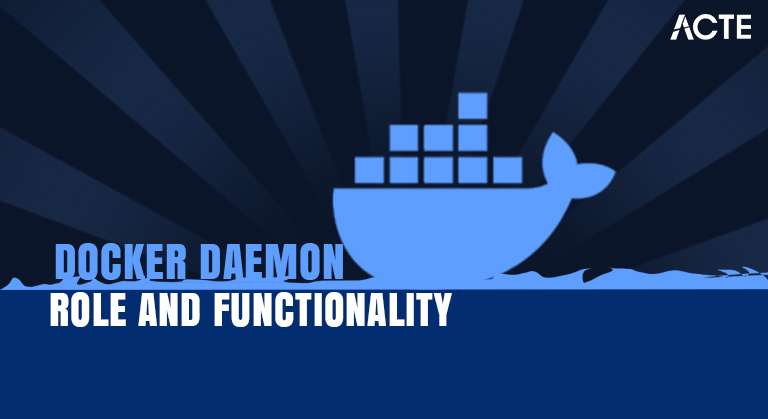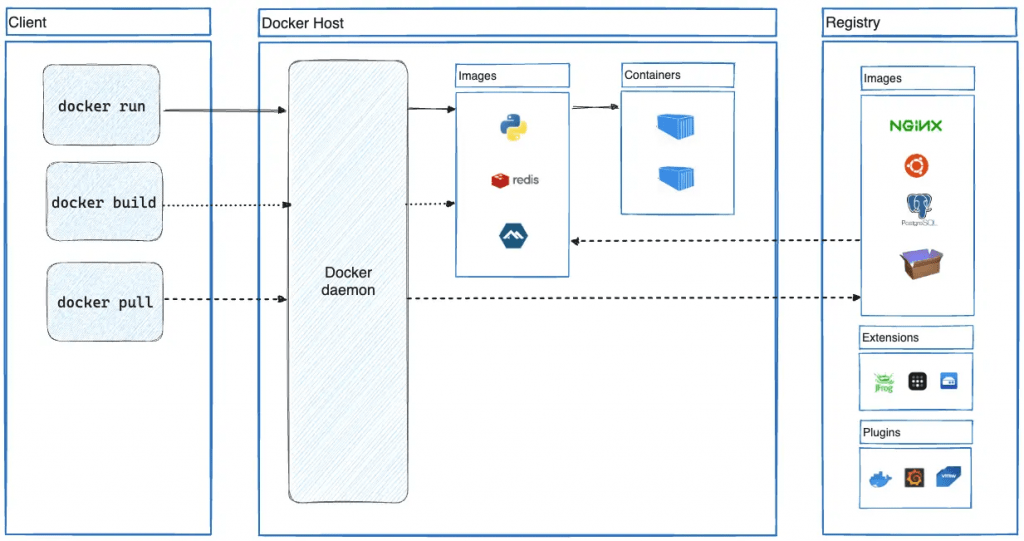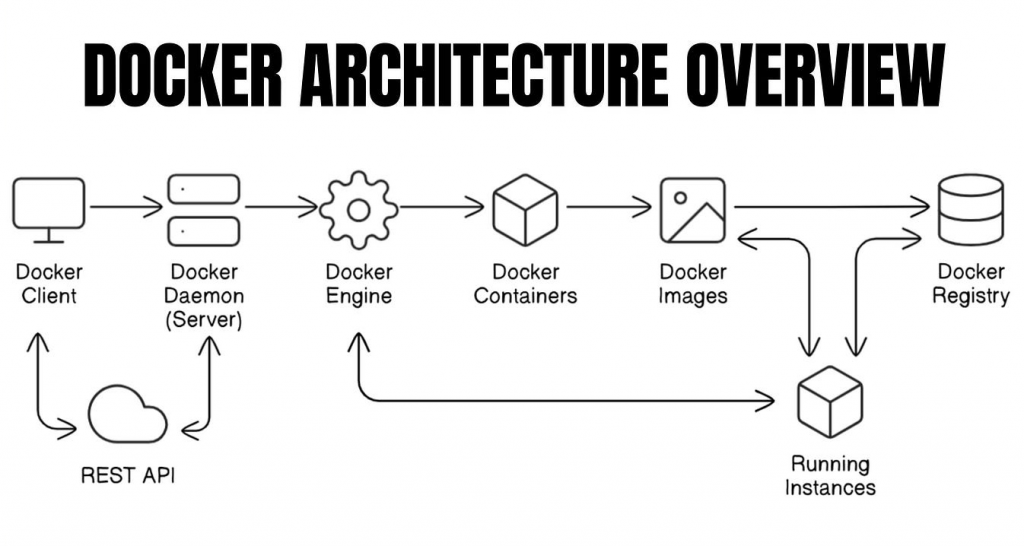
- Introduction to Docker Daemon
- Role of the Docker Daemon
- How Docker Daemon Works
- Docker Daemon vs Docker Client
- Key Components of Docker Daemon
- Configuration of Docker Daemon
- Monitoring and Managing Docker Daemon
- Common Problems and Troubleshooting
- Best Practices for Docker Daemon Management
- Conclusion
Introduction to Docker Daemon
The Docker Daemon is often referred to as `dockerd`. It is the core component of Docker, an open-source platform that allows developers to automate the deployment of applications inside lightweight, portable containers. Docker Daemon manages the Docker containers, images, networks, and volumes on a system. It runs as a background process on the host machine and oversees the entire lifecycle of containers, from creation to execution, ensuring that the containers are running as intended. Docker uses a client-server architecture with the Docker Daemon, which acts as the server. Requests are received by the Docker daemon from the Docker client, including the CLI and GUI, a process that is typically explained in Cloud Computing Courses to help learners understand how containerization and cloud-based applications interact. A terminal or via the Docker API, the client can send commands to the daemon. The tasks that the Docker daemon performs include building images, managing containers, and managing networking for containers. In a nutshell, the Docker daemon is an execution environment for Docker containers and ensures that containers are operated smoothly across environments; that is, from your local machines to cloud servers. And in order to work with Docker, knowledge of the Docker daemon is a necessity since it constitutes the whole process of containerization.
To Earn Your Cloud Computing Certification, Gain Insights From Leading Cloud Computing Experts And Advance Your Career With ACTE’s Cloud Computing Online Course Today!
Role of the Docker Daemon
- Container Lifecycle Management: The Docker Daemon is responsible for creating, running, and stopping containers, and can be integrated with tools like Azure Active Directory for enhanced security and access management when deploying containerized applications in the cloud.This means that containers are started, executed, and stopped according to user commands and maintain their state throughout their lifetime.
- Building and Storing Docker Images: The Docker Daemon is responsible for building container images from a Dockerfile, which contains instructions on how the image should be constructed. It can also pull images from Docker Hub or other container registries, and it stores these images locally for use in container creation.
- Networking and Communication: The Docker Daemon manages the networking for containers, meaning that containers will be able to communicate with one another and with the outside world. This means setting up network bridges, management of IP addresses, and routing traffic between the containers and other networks.
- Docker Volumes Management: The Daemon also manages the creation, deletion, and management of Docker volumes, which are used to persist data across container restarts and ensure that data is accessible to containers as needed.
- Docker Client and API Interface: The Docker Daemon listens for commands from the Docker client, processes those requests, and sends back the results. It exposes an API that enables automation and integration with other services.
- Docker Daemon (Server): Docker Daemon, or `dockerd`, is the background service that manages the containers and images, as well as the networks and volumes. It is responsible for creating, running, stopping, and building images in a system, which plays a vital role in various Cloud Deployment Models, ensuring efficient management and scalability of applications across different cloud environments. It maintains resources like volumes and networks. daemon processes are run on the host machine and listens to API requests, both from local space and remote locations. It is the core of Docker architecture, which makes sure the containers are well managed and executed appropriately.
- Docker Client: This is the interface, making it possible for the user to interact with the Docker Daemon. It can be accessed using a CLI or GUI. The Docker Client will send commands to the Docker Daemon. The Docker Daemon takes this request in its process and then returns the results back to the client. For example, if a user gives `docker run` at the terminal, it is going to communicate with the daemon, making the container start. The Docker Client can be installed on a local machine and communicate with a Docker Daemon running on a remote server, making it possible to manage Docker containers on multiple systems. The Client only sends commands; it doesn’t manage containers or images directly, as that responsibility lies with the Daemon.
- Docker Engine: This is the main component of the Docker Daemon responsible for running the containers and controlling their lifecycle, similar to how The Ultimate Guide to Ethernet Networks helps manage the communication and data flow within networks, ensuring smooth operations and connectivity. It has a container runtime through which containers are launched, run, and terminated.
- Image Store: Local image storage is provided by the Docker Daemon, and it keeps container images. These images can be built locally from a Dockerfile or pulled from a container registry like Docker Hub or a private registry. The image store assists the Daemon in managing images and ensuring images are ready for a container to be built.
- Container Runtime: Container runtime is a significant component of the Docker Daemon that runs and manages containers. It uses a technology like containerd or runc to run the containers and handle their resource allocation.
- Networking Components: Docker provides built-in networking components that are managed by the Daemon. These include network drivers, IP address management, and routing rules. Docker networks allow containers to communicate with each other and external networks while ensuring isolation between different applications.
- Volume Management: The Docker Daemon includes components for managing volumes, which are used to store persistent data. The Daemon ensures that volumes are created, attached to containers, and available even after containers are stopped or removed.
- API and CLI: The Docker Daemon exposes an API that can be accessed through the Docker CLI or other services. This API enables users to automate container management tasks and integrate Docker with other applications.
- Docker CLI Commands: The Docker CLI provides quite a number of commands to engage with and run the Daemon. Some of such commands include docker ps, where it shows running containers, docker logs, which give container logs and docker stats resource usage statistics about containers.
- Docker Daemon Logs: Monitoring the Docker Daemon logs is critical for troubleshooting and identifying issues. You can view the Daemon logs by checking system logs or by using the `journalctl` command (on Linux systems). Docker also logs events related to containers, images, and networks.
- Monitoring Tools: Many monitoring tools may be integrated with Docker to trace the health and performance of containers and the Daemon itself. Some of these tools include Prometheus and Grafana, whereby you may visualize container metrics and system performance by fetching metrics from the Docker Daemon.
- Docker API: It exposes a Docker Daemon as RESTful API by which containers are programmatically monitorable and even manageable. All the above jobs can be accomplished through API automatically, such as checking health container, scaling a service, doing updates, and so on.
- Docker Compose: Docker Compose is used for managing multi-container applications. It makes the process of managing Docker containers easier and can be used with monitoring tools to track the performance of each container in a service.
- Resource Limits: Set limits on resources used by containers and the Docker Daemon to prevent the system from becoming overloaded and running inefficiently. This can include limiting CPU and memory usage.
- Regular Updates: Always keep the Docker Daemon and its components up to date to benefit from the latest features, bug fixes, and security patches. Use the appropriate package manager (e.g., `apt-get` for Ubuntu) to update Docker.
- Optimize Resource Usage: Configure containers with proper resource limits (e.g., CPU, memory) to prevent one container from consuming too much. Use the `–memory` and `–cpus` flags to set resource limits.
- Security Best Practices: Implement security measures such as enabling TLS for Docker Daemon communication, using secure Docker images, and ensuring containers run with least privilege. Consider using Docker Content Trust (DCT) to verify image signatures.
- Logging and Monitoring: Establish centralized logging and monitoring for Docker containers and the Daemon. Prometheus and Grafana can be used to monitor container metrics in real time and track anomalies.
- Docker Management Automation: Use Docker Compose or orchestration tools like Docker Swarm or Kubernetes to automate the deployment, scaling, and management of containers.
- Cleanup Unused Resources: This is done periodically by pruning unused containers, images, and volumes that occupy disk space. Use the command `docker system prune` to remove unnecessary resources.

How Docker Daemon Works
Communication from Docker Client as soon as an end user commands the Docker client, the given command is then forwarded to the Docker daemon through a RESTful API. Often, this may be done using a Unix socket locally or with a TCP socket remotely. As such, interaction between the client and the Daemon is done over HTTP requests. Container Management after the Docker Daemon has received a request, it processes the command. The process may include creation, starting, stopping, or deleting containers. For instance, if a user requests to run a container, the Docker Daemon will pull an image that corresponds to the necessary image, then create a new container based on the image pulled and start it. Image Management The Daemon is responsible for building and managing Docker images, a key aspect of both DevOps vs DevSecOps, where image security and efficient management are crucial in the continuous integration and delivery pipeline. When an image is built from a Dockerfile or pulled from a registry, the Daemon handles storing the image in its local storage. The Daemon also ensures that images are shared across containers and that any changes made to containers are captured in image layers. The Docker Daemon configures network settings for containers, such as creating network bridges and assigning IP addresses to containers. It manages the communication between containers and handles any firewall or routing rules needed for container interaction with external networks. Docker volumes, used to store persistent data, are created and managed by the Daemon. This ensures that data persists beyond the lifecycle of individual containers. Through these activities, the Docker Daemon ensures a stable and efficient environment for managing containers and their resources.
Are You Interested in Learning More About Cloud Computing? Sign Up For Our Cloud Computing Online Course Today!
Docker Daemon vs Docker Client
Docker uses a client-server architecture, and it is important to differentiate between the roles of the Docker Daemon and Docker Client:
To put it in summary, the Docker Daemon controls the life cycle of the containers and resources, whereas the Docker Client acts as a terminal through which the commands are given to the Daemon.
Key Components of Docker Daemon

Gain Your Master’s Certification in Cloud Computing by Enrolling in Our Cloud Computing Masters Course.
Configuration of Docker Daemon
Change Docker Daemon Configuration file for Docker is usually located at `/etc/docker/daemon.json`. It contains several settings that control the Daemon’s behavior. Some of the things you can change include the default storage driver, logging options, and registry mirror settings. Networking Configuration: You can configure the networking settings of the Docker Daemon to manage how containers communicate with each other and external systems, a key concept taught in Cloud Computing Courses to help professionals understand container networking and cloud infrastructure management. This can include creating custom networks, adjusting the subnet, or specifying network drivers like bridge, host, or overlay. Enable/Disable Features of Docker Daemon can be set up to have certain features enabled or disabled. Such features include enabling Docker Swarm mode for clustering, or setting up logging drivers for defining how the logs are kept. These settings are helpful when enterprise environments are required to keep specific logging or clustering configurations. Security Settings the Docker Daemon can be configured to enforce security policies, including enabling TLS encryption for communication with the Daemon or setting up user authentication for accessing Docker APIs. Resources and Performance Daemon can be configured to limit resources such as CPU, memory, and disk space for containers. This ensures optimal performance and prevents one container from consuming excessive resources.
Monitoring and Managing Docker Daemon
Monitoring and managing the Docker Daemon is very essential for ensuring the stability and performance of your Docker environment. Here are some approaches to monitor and manage the Daemon:
Proper monitoring of the Docker Daemon ensures a smooth-running daemon and, thus, finds and clears problems in good time.
Common Problems and Troubleshooting
Docker Daemon Fails to Start One common issue is when the Docker Daemon fails to start, often due to configuration errors or insufficient system resources. Check system logs (`journalctl -u docker.service`) to identify errors. Ensure that the configuration file (`daemon.json`) is correctly set up. Containers might fail to run due to an image problem, missing dependencies, or conflicting configurations. Use the command `docker logs
Best Practices for Docker Daemon Management
Preparing for Cloud Computing Job Interviews? Have a Look at Our Blog on Cloud Computing Interview Questions & Answer To Ace Your Interview!
Conclusion
This represents the core piece of Docker’s containerization system, responsible for managing containers and images, their networking, as well as general resources. A good understanding of the role, key components of the Docker daemon, and exactly how it operates will help companies use Docker with maximum efficiency toward application development and testing and efficient deployment. Configuration, monitoring, and troubleshooting of the Docker Daemon are to be done right so that any issues with containers are resolved before they cause too much trouble, which is a critical topic covered in Cloud Computing Courses to ensure effective management of containerized environments. Organizations can further optimize the performance and reliability of their Docker environment by following the best practices for regular updates, security measures, and resource optimization. As containerization becomes an increasingly essential part of modern software development and deployment, it is indispensable for DevOps teams, system administrators, and developers to learn how to master Docker Daemon management. With such a rich feature set and an abundance of tools, Docker delivers an environment where applications can run and be managed efficiently, at scale, and in a secure manner.





